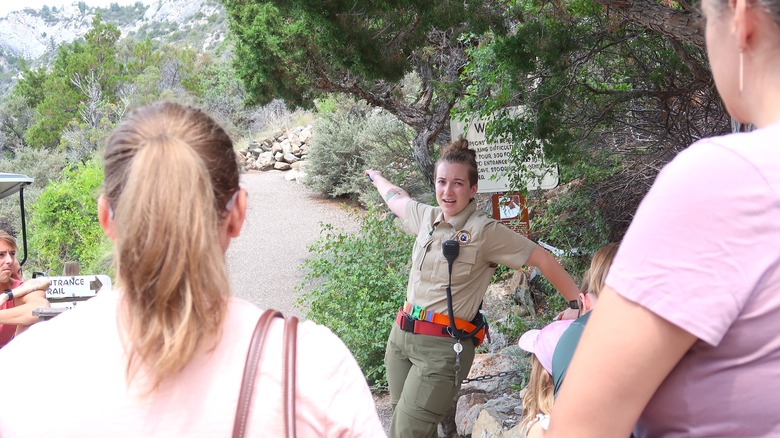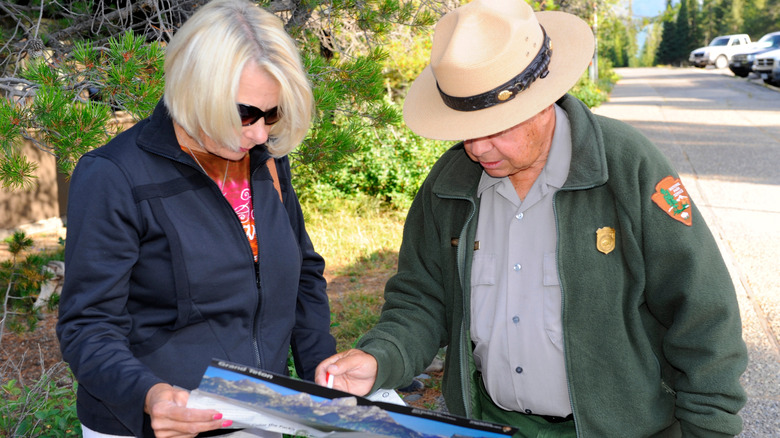What It Means When A Park Ranger Starts Asking Questions About Your Hike
If you've ever had a park ranger approach you while preparing for a hike and ask specific questions about your plans, they're not just making small talk. Their questions are strategic attempts to ensure your outdoor safety. National parks are some of the most incredible places to visit during your travels, especially if you're a nature lover. There are thousands to choose from all over the world, but they can be dangerous if you're not prepared.
The US is home to 63 official national parks and around 400 national parks sights, all of which are managed by an incredible team of park rangers. Park rangers have a big job and wear lots of hats. They serve as law enforcement officers, stewards of the land, educators, maintenance personnel, and emergency first responders.
The official mission statement posted on the National Park Service website states their goal is to provide "quality law enforcement to safeguard lives, protect our national treasures and symbols of democracy, and preserve the natural and cultural resources entrusted to us." Author and professor Kurt Caswell eloquently wrote that "a park ranger is a protector. You protect the land from the people, the people from the land, the people from each other, and the people from themselves." One of the many ways park rangers protect visitors is through asking them questions about their hiking plans as part of preventative search and rescue (PSAR) efforts.
Preventive search and rescue initiatives aim to help reduce emergencies within national parks
PSAR is intended to reduce the need for search and rescue missions through preparation, education, and information. When a park ranger approaches you and begins asking detailed questions about your plans for the day, they're trying to ensure you have the skills and equipment necessary to enjoy a safe experience. PSAR aims to stop accidents and emergencies before they happen, similar to how preventive medicine aims to promote and protect your health even when you're not sick. It also helps cut down on dangerous tourist activities that are all too common — like breaking park rules for the sake of taking selfies in risky places.
The PSAR movement began as a response to an increasing number of search and rescues in the 1990's at Grand Canyon National Park. As national parks became more popular amongst the general public, medical emergencies skyrocketed. According to the NPS, the number of searches and rescues doubled between 1983 and 1986. Park rangers quickly became overwhelmed and exhausted and rescues were costing the NPS a lot of money.
The Grand Canyon National Park commissioned ten park rangers to come up with a plan to cut down on search and rescues. The result of their findings led to the creation of the first PSAR team in 1997. Now, park rangers trained in PSAR are deployed in "arduous environments" throughout America's national parks. Park rangers who specialize in PSAR are trained to educate visitors about particular challenges they may face while visiting a particularly risky area within a national park.
What to expect from an encounter with a PSAR park ranger
PSAR trained rangers ask strategic questions in an attempt to gauge whether or not you're prepared for the adventure you're about to embark on and whether or not you understand potential dangers you may encounter along the way. In Yosemite National Park, park rangers conduct around 250 search and rescue missions each year. Venomous snake bites, fast moving water, and falls are a few of the common threats SAR teams focus on.
PSAR park rangers in Yosemite may approach you and ask questions about your level of experience hiking in the backcountry or make recommendations about water safety. If they feel you're unprepared, they may suggest easy and scenic hikes for beginners as an alternative. In the Grand Canyon, PSAR park rangers may ask you if you have enough water to complete your hike, especially during the hot summer months.
You may be asked if you know how long your hike will take or if you're aware of current weather conditions. If you're hiking in the late afternoon or evening, they may ask whether you have a flashlight packed. None of these questions are intended to stop you from exploring the most beautiful places, they're to help you stay safe. "Although information about the trails is available at the Visitor Center and on signs posted at the trailheads, many hikers are still surprised when a PSAR Ranger talks to them about their planned hike. If you meet a PSAR Ranger on your hike remember our goal is not to discourage you but to help you have a safe and positive experience," said a park ranger on a podcast on the National Park Service website.


